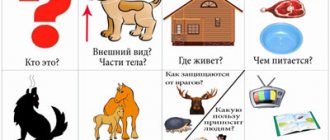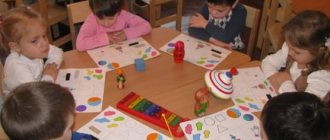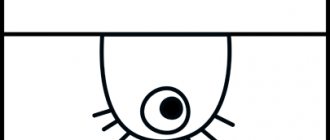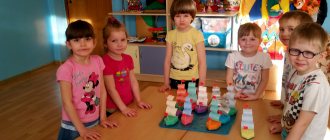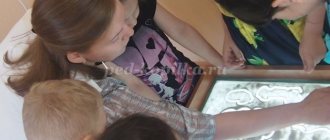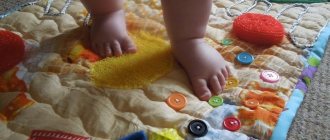Quote from the message to MY_GRANDCHILDREN_USEFUL
Read in full In your quotation book or community!
What is mnemonics and how to work with mnemonic tables for children’s development
Mnemonics helps young children:
- It is easier to remember poems, tongue twisters, riddles, stories;
- Recode information from visual to abstract and vice versa;
- Build a logical chain of events and reproduce the story in the correct order (beginning - middle - ending);
- Enriches vocabulary;
- Helps develop thinking;
- Develops imagination;
- Helps write long descriptive sentences and coordinate tenses.
This technique uses visual aids - tables. In speech development classes, teachers often use mnemonics and ask children to decipher and memorize images on tables. Tables can have a wide variety of designs and themes.
There are the following mnemonic tables:
- For poems, riddles or fairy tales;
- To remember the rules;
- For stories.
Modern children are surrounded by a mass of information; most often, they do not have time to assimilate it, and therefore have problems reproducing it. Preschool children often have a fairly large vocabulary, but they only make up simple sentences that they cannot put together into a complete logical story. Mnemonic tables teach children to plan a story and reproduce it in a logical order. The use of mnemonic tables significantly improves the educational process, children learn faster.
What is mnemonics
The concept is associated with a system that helps to assimilate large amounts of information. These are exercises that help evoke associations and remember. Associations can be kinesthetic (tactile), visual (visible), auditory (auditory).
How to remember a date from history?
Imagine that this is the day and month of “your acquaintance” with a historical character. Or the day when “you visited” the site of a historical event.
Everyone can associate differently. The task of parents is to teach the child to find the association on his own based on examples and remember it. And then reproduce it in memory.
Teaching mnemonics to schoolchildren
If you have a schoolchild or teenager, we advise you to contact a teacher who will select exercises that suit your child’s personality type. For self-study, we offer you the following exercises.
No. 1. Composing acrostics
If you need to commit a series of words or numbers to memory, try forming a phrase from the first letters. Remember how to remember the colors of the rainbow? "Every Hunter Wants to Know Where the Pheasant Sits." The principle is the same in this exercise.
No. 2. Rhyming
The technique suggests putting complex rules, lists of words, numbers into short poems. The more delirious the quatrain, the faster the lines are ingrained into memory. Rhyming is probably familiar to many from geometry lessons, explanations of complex concepts in verse: “A bisector is a rat that runs around the corners, dividing the corner in half.”
No. 3. Story method
When it is necessary to remember a series of words or what is drawn in a picture, a story is compiled from these words. The components of the structure are connected by a single semantic chain. Watch how associative chains create stories in this video:
No. 4. Search for consonant words
This mnemonic technique for beginners makes it easy to memorize foreign words.
- Let's take a foreign word (for example, the English “House”)
- We find a consonant association in a familiar language, imagine a picture (House is similar to “Chaos” that always reigns at home.)
- We repeat 2-3 times a day for memorization (we call up the same picture in our head for associations).
No. 5. Cicero's method
Cicero memorized information by arranging it “on shelves” in an imaginary room. You can also use this method. The technique is convenient for quickly assimilation of a huge amount of data. If you master this technique with your child, you will be surprised by your ability to remember information.
Imagine a museum in your mind - a detailed room with shelves, chests of drawers, chests. This is your data “storage system”. Mentally “tie” what you need to remember (an object, a word, a number) to a specific object in your room. Imagine it vividly. To remember, just mentally “take this off the shelf.”
No. 6. Aivazovsky method
Aivazovsky, a famous artist, had an excellent photographic memory. He memorized landscapes in detail and then depicted them on paper. This mnemonic technique will develop photographic memory.
- An object, a painting or part of a landscape with a lot of detail will do. Consider. Remember it.
- Mark important details where they are located in the picture.
- Close your eyes, reproduce the image in all details.
- Open it and look at the object. Check, did you remember everything? Repeat again to remember more details.
Where and who will use mnemonics?
- For children - to remember information in school and kindergarten. Learning poetry with this technique is a pleasure for both children and parents.
- For students - to effectively pass the session and tests. It’s easy to repeat and remember the year’s material in a week! The main thing is to use techniques.
- For adults - at work, in making presentations, in planning things, making shopping lists and much more.
No talent or special abilities are needed to teach mnemonics. We need systematic, disciplined training. Have information you need to remember? Remember one of our exercises and put it into practice with your children.
Tips for using mnemonics
- Start with the basics. Don't try to remember large amounts of data at once. Practice on single images, short lists of words, dates. Focus on the techniques that mnemonics offers for beginners: the method of stories or visualization. Increase the difficulty gradually, noticing progress at previous stages.
- For training, choose bright images; for children, always color ones. Such illustrations attract attention better, allow you to focus on details, and highlight more associative connections.
- Don't get overwhelmed. For children, 2 mnemonic tables per lesson are enough, no more than 9 squares per piece. A large amount of data causes boredom and in the form of a game.
- Make mnemonics classes varied. Change exercises, topics, memorize texts, illustrations and numbers.
- Remember that you need to exercise regularly. Perform 1-3 exercises daily, gradually limiting the time or increasing the load.
The essence of the technique
Modern children, due to their immersion in the world of computer technology and busy parents, have many speech problems:
- inability to use complex and long sentences in speech,
- lack of skill to formulate thoughts,
- poor vocabulary, use of non-literary vocabulary, abbreviations in speech,
- inability to formulate questions and answers,
- bad diction,
- inability to build statements and draw conclusions.
The use of mnemonics allows you to effectively correct these shortcomings and make children’s speech rich and beautiful. In addition, it helps the development of:
- auditory and visual memory,
- imagination,
- perseverance,
- interest in learning,
- visual perception,
- associative thinking,
- logical thinking,
- skills of analysis and synthesis.
In modern speech therapy, the use of mnemonics begins at the age of 4, sometimes even at the age of 3. At the same time, articulatory gymnastics techniques are also used to eliminate pronunciation defects (you can read about them here).
Mnemonics, or memorization techniques, is an integral system of methods that are aimed at maximizing memorization and reproduction of the materials being studied. It is based on visual perception and further reproduction of information using certain images (more about this here).
When compiling mnemonic tables for speech development, a corresponding picture is used for a specific word. By studying the images offered to him, the baby can easily remember and reproduce the desired text.
In this case, information is tied not only to the picture itself, but also to the sensations that are associated with it (color, size, taste, smell). All these sensations are combined into an associative series, creating complex connections between nerve cells, which contributes to the memorization and reproduction of information.
In other words, a mnemonic table is a specific, specific diagram that acts as a visual aid and conveys the necessary information.
Abstract of the educational activity “Colors of Autumn” on speech development using mnemonic tables in the senior group
Lyudmila Parkhomenko
Abstract of the educational activity “Colors of Autumn” on speech development using mnemonic tables in the senior group
Educational areas: “Speech development ”
,
“Cognitive
development ” ,
“Socio-communicative
development ” Technologies: gaming, speech, health-preserving, cooperation, dialogue interaction, communication.
Goal: development of creative abilities in the process of solving a specially simulated problem situation “Features of autumn as a season ”
.
Educational: improve the level of accumulated knowledge on speech development and familiarization with the environment;
-continue to teach how to compose stories using reference diagrams ( mnemonic tables )
about
autumn ;
- to activate children’s speech, paying attention to the prosodic side of speech .
Developmental : develop dialogic and monologue speech, attention, memory, thinking;
-develop search activities to solve the problem;
-develop partnerships, coordination of speech and movement .
Educating: revive aesthetic impressions caused by observations of autumn phenomena in nature , cultivate a sense of beauty ;
-to form friendly relationships, cooperation skills, initiative, and the ability to listen to a friend.
Material: a letter from Pinocchio, which contains a riddle, pictures with signs of autumn , mnemonic tables ; poems about the autumn months , autumn leaves according to the number of children.
Preliminary work: excursions around the territory of the kindergarten;
-observations of changes in nature;
-reading fiction: N. Sladkov “ Autumn is on the threshold ”
, M. Prishvin
“It’s cold for the aspen trees”
, A. Pleshcheev
“The rowan tree
is turning red ” ,
“
Autumn has come ” , V. Bianchi
“Sinichkin’s calendar”
;
-examination of paintings and illustrations depicting an autumn landscape ;
-learning poems on autumn themes ;
-application “Gifts of Autumn ”
, origami
“
Autumn tree ” , drawing
“
Autumn leaves ” ,
“
Golden autumn ” ,
“Late
autumn ” .
Books on mnemonics for children
- “Learning from a fairy tale”, T.V. Bolshakova;
- “Supermemory for everyone”, E.E. Vasilyeva, V. Yu. Vasiliev;
- “Remember everything. Practical guide to memory development”, Arthur Dumchev;
- “Brain development. How to Read Faster, Remember Better, and Achieve Bigger Goals by Roger Sipe;
- “Einstein walks on the moon. The Science and Art of Memory,” Joua Foer;
- A. R. Luria. “A little book about a big memory”;
- How to Develop Super Memory by Dominic O'Brien.
The books describe in detail common techniques, proprietary methods, give tips on mastering and demonstrate the work with examples.
Features of application
You can achieve results during mnemonics classes if you follow the basic rules for using the technique.
- Subsequence. You cannot start classes with difficult tasks. First they work with mnemonic squares, single images, then with mnemonic tracks and mnemonic tables.
- Rationing. Children are not shown more than two tables per day, and the number of images in each block should be no more than 9 pieces. Too much information is difficult for a child to absorb, so classes will be ineffective.
- Colorfulness. The pictures should interest the child in their appearance. They use bright colors, rich and expressive images. Tables in black and white will not be able to attract the attention of children and have the desired impact; they can only be used for children of older preschool age.
- Emotionality. Children should feel the positive energy of such activities.
- Diversity. Pictures or series of images for one lesson should be on different topics. Guys will quickly lose interest in the same type of training. It is also advisable to select tables that require different actions. For example, the first pictures help to remember the sequence of food intake, and the next group helps to tell about how insects move.
- No coercive measures: just a game. Classes can only be conducted when children are involved in the process with pleasure and interest. Everything should happen in a playful way. If the children's attention wanes, it is better to stop the lesson and continue at another time.
It is enough to adhere to these simple principles to achieve maximum learning results.
